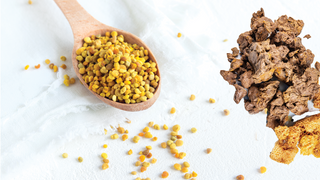Nowadays, there is a growing interest in the physiological benefits of natural antioxidants in foods. Honey bee products, especially propolis and pollen, have strong antioxidative activity and beneficial effects in human body. The aim of this study was to determine the total phenolic and total flavonoid contents and antioxidant activities of propolis and pollen, as well as bioaccessibility of these products by an in-vitro model simulating gastrointestinal digestion. Total phenolic content, total flavonoid content and antioxidant activity analysis were applied to all samples as well as samples collected after the application of in-vitro gastrointestinal method. Phenolic profiles of propolis and pollen samples were also identified by HPLC-PDA. Results indicated that total phenolic contents of IN fractions (bioaccessible fraction) of propolis and pollen was 2.0 and 2.1 mg GAE/g; total flavonoid content was 0.9 and 0.2 mg QE/g; total antioxidant activity was 19.6 and 0.6 mg TE/g, respectively. Percentages of the IN fraction of propolis and pollen were 1% and 9% for total phenolic content; 0.2% and 1% for total flavonoid content; 4% and 3% for total antioxidant activity. Phenolic compounds including caffeic acid, p-coumaric acid, ferrulic acid, quercetin, pinobanksin, apigenin, t-cinnamic acid, luteolin, pinocembrin, chrysin, galangin, kaempferol and pinostrobin were detected in propolis, and 2-hydroxycinnamic acid, quercetin-3-glucoside, quercetin, myricetin, luteolin, quercetin-3-galactoside, kaempferol, and galangin were detected in pollen samples.
Read More: https://www.tandfonline.com/doi/abs/10.3896/IBRA.1.53.1.10

